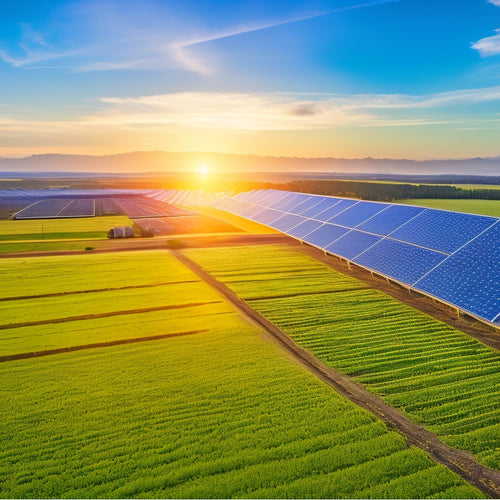
What Components Make Up a Solar Panel Energy System?
Share
As you investigate your solar panel energy system, you'll find it's comprised of several essential components. First, there are the solar panels themselves, which convert sunlight into electricity, including crystalline silicon, thin-film, and bifacial modules. Next, mounting systems, such as roof or ground installations, secure the panels while optimizing energy production. Tracking systems, like single-axis or dual-axis trackers, help maximize sunlight capture. Inverters and power converters change DC power into AC for home use, while energy storage systems and batteries store excess energy for later use. Finally, charge controllers, monitoring systems, and energy management components work together to optimize system performance - now that you know the basics, you can uncover how each component works together to generate clean energy.
Key Takeaways
- A solar panel energy system consists of solar panels and modules that convert sunlight into electricity, with crystalline silicon and thin-film being the two main categories.
- Mounting systems, including roof and ground options, securely attach solar panels while maximizing energy production and complying with local building codes.
- Tracking systems, such as single-axis, dual-axis, and active trackers, optimize sunlight capture and increase energy output by up to 45%.
- Inverters and power converters, including string inverters, microinverters, and power optimizers, convert DC power into AC power for home use and grid connectivity.
- Energy storage and battery systems, along with charge controllers and regulators, store excess energy for use during nights or cloudy days and manage energy flow to extend battery lifespan.
Solar Panels and Modules
Each solar panel energy system relies on a collection of solar panels and modules to convert sunlight into electrical energy.
You'll find that these solar panels are made up of photovoltaic (PV) cells, which are responsible for converting sunlight into electricity. The efficiency of these PV cells can vary depending on the type of solar panel you're using, with monocrystalline panels offering the highest solar panel efficiency.
When it comes to solar module types, you'll typically find two main categories: crystalline silicon and thin-film modules. Crystalline silicon modules are the most common type and offer high efficiency, while thin-film modules are less efficient but more affordable.
You'll also come across bifacial modules, which can absorb sunlight from both the front and back sides, increasing energy output.
As you investigate your solar panel energy system, you'll notice that the modules are arranged in a specific pattern to enhance energy production. This arrangement is designed to guarantee that each module operates at its peak level, resulting in a more efficient energy system.
Mounting and Tracking Systems
You'll need to decide how to securely fasten your solar panels to your roof or ground, and you have several options to contemplate.
Roof mounting options range from simple attachment to existing rafters to more complex systems that integrate with your roofing material.
Additionally, you can choose from ground mounting systems or solar trackers, each with their own set of benefits and installation requirements.
Roof Mounting Options
When integrating a solar panel energy system into your home, one of the most critical considerations is how to securely fasten the panels to your roof while guaranteeing maximum energy production.
You'll need to choose a roof mounting option that addresses installation challenges, such as roof type, size, and orientation, while also meeting aesthetic considerations.
Roof mounting options include rail-based systems, which provide a sturdy structure for your solar panels, and rail-less systems, which offer a more streamlined appearance.
You may also consider integrated mounting systems that combine the mounting hardware with the roofing material, providing a seamless look.
Additionally, you'll need to decide on the type of clamps and brackets to use, depending on your roof's material, such as asphalt shingles, metal, or tile.
Confirm that your chosen mounting option is compatible with your roof's design and local building codes.
Ground Mounting Systems
Beyond roof-mounted systems, ground mounting systems offer an alternative for homeowners who prefer not to attach solar panels to their roof or have constraints that prevent roof installation.
You'll typically find these systems in open spaces, such as backyards or fields, where they can be installed on fixed structures. These structures can be customized to fit your specific needs, allowing for the best energy production.
When it comes to installation techniques, ground mounting systems often involve digging trenches or pouring concrete to create a solid foundation. This guarantees the system remains stable and secure, even in harsh weather conditions.
You can choose from various installation methods, including screw-based, ballasted, or concrete-based systems. Each method has its advantages and disadvantages, and your installer will help you determine the most suitable approach for your site.
Ground mounting systems provide more flexibility regarding panel orientation and angle, allowing you to maximize energy production.
Additionally, they're often easier to clean and maintain compared to roof-mounted systems. With the right installation and maintenance, a ground mounting system can provide you with a reliable source of renewable energy for years to come.
Solar Trackers Types
Solar trackers, a type of mounting and tracking system, optimize energy production by adjusting the angle and orientation of solar panels to capture the maximum amount of sunlight throughout the day.
You'll benefit from increased energy output by up to 45% compared to fixed-tilt systems.
There are different types of solar trackers, each with its own advantages and limitations.
You should consider the following:
-
Single Axis Trackers: These trackers adjust the angle of the solar panels to follow the sun's daily movement from east to west. They're more cost-effective and widely used in large-scale solar farms.
-
Dual Axis Trackers: These trackers adjust the angle and orientation of the solar panels to follow the sun's daily and seasonal movements. They're more precise, but also more expensive and complex.
-
Active Trackers: These trackers use sensors and motors to continuously monitor and adjust the solar panels' angle and orientation. They're more accurate, but also require more maintenance.
When choosing a solar tracker, consider factors such as your budget, available space, and local climate to maximize your energy production.
Inverters and Power Converters
You'll need an inverter to convert the DC power generated by your solar panels into AC power, which is what your home or business uses. This conversion is vital for grid connectivity, as it allows you to feed excess energy back into the grid and offset your electricity bills.
Inverters also play a significant role in system efficiency, as they optimize energy output and minimize losses.
There are different types of inverters, including string inverters, microinverters, and power optimizers. String inverters are the most common, connecting multiple solar panels in a string to a single inverter.
Microinverters, on the other hand, are installed beneath each solar panel, converting DC power to AC power at the panel level. Power optimizers offer a hybrid approach, combining the benefits of string and microinverters.
When selecting an inverter, consider factors such as efficiency, reliability, and compatibility with your solar panel system. Look for inverters with high conversion efficiency, as they'll maximize your energy output.
Additionally, verify your inverter is compatible with your grid connectivity requirements and meets local regulations.
Charge Controllers and Regulators
In conjunction with your inverter, charge controllers and regulators play an essential role in managing the flow of energy from your solar panels to your battery bank.
These components guarantee that your battery bank is charged safely and efficiently, preventing overcharging or undercharging that can reduce its lifespan.
Here are three key functions of charge controllers and regulators:
-
Voltage Regulation: They regulate the voltage output from your solar panels to match the voltage requirements of your battery bank, guaranteeing a safe and efficient solar charge.
-
Maximum Power Point Tracking (MPPT): Charge controllers and regulators track the maximum power point of your solar panels to optimize energy production, even in changing environmental conditions.
-
Overcharge Protection: They prevent your battery bank from overcharging, which can cause damage or even fires, and also prevent undercharging, which can reduce its overall capacity.
Energy Storage and Batteries
As your solar panel energy system generates electricity, it's essential to store excess energy for later use. This is where energy storage and batteries come into play. You'll need a reliable battery system to store the excess energy generated during the day for use during the night or on cloudy days.
When selecting a battery technology, you'll want to take into account factors such as depth of discharge, round-trip efficiency, and lifespan. Popular battery technologies for solar panel energy systems include lead-acid, lithium-ion, and nickel-cadmium.
Effective energy management is also vital to guarantee you're getting the most out of your solar panel energy system. This involves monitoring your energy usage and adjusting your energy storage accordingly.
Monitoring and Control Systems
With your solar panel energy system up and running, it's vital to keep tabs on its performance to guarantee ideal energy harvesting and storage. Monitoring and control systems are fundamental for optimizing your system's performance, identifying potential issues, and ensuring maximum energy output.
These systems typically consist of advanced software and hardware components that track your system's performance in real-time.
You'll be able to:
-
Analyze performance data: Monitor your system's energy production, consumption, and storage in real-time, allowing you to identify areas for improvement.
-
Visualize data findings: Employ data visualization tools to gain a deeper understanding of your system's performance, making it easier to make informed decisions.
-
Receive alerts and notifications: Stay informed of any system malfunctions or performance issues, ensuring prompt maintenance and minimizing downtime.
Frequently Asked Questions
Can I Install a Solar Panel Energy System Myself?
You can try installing a solar panel energy system yourself, but be aware of installation challenges and prioritize DIY safety; without proper training and experience, you may void warranties or compromise system efficiency and your own well-being.
How Long Does a Solar Panel Energy System Warranty Last?
As you gaze up at your newly installed solar panel energy system, you wonder, how long will it be protected? Typically, you'll enjoy a 25-year warranty, but beware, warranty coverage varies, and warranty limitations can leave you exposed to unexpected costs.
Are Solar Panel Energy Systems Resistant to Extreme Weather?
You'll be relieved to know that solar panel energy systems are designed to withstand extreme weather conditions, boasting impressive durability and resilience, with most systems engineered to last for decades even in harsh environments like hurricanes or hail.
Can I Use Solar Panels to Power My Electric Vehicle?
As you utilize the power of the sun, you're likely wondering if solar panels can fuel your electric vehicle's next journey; with advanced solar charging, you can optimize electric vehicle efficiency, making your eco-friendly ride a reality.
Do Solar Panels Require Regular Cleaning for Optimal Performance?
You'll need to prioritize solar panel maintenance, as neglecting regular cleaning can reduce efficiency by up to 25%. Determine your cleaning frequency based on environmental factors, like dust and debris, to guarantee peak performance and maximize your energy harvest.
Conclusion
You've now got an extensive summary of the key components that make up a solar panel energy system. From solar panels and mounting systems to inverters, charge controllers, energy storage, and monitoring systems, each part plays an essential role in capturing and utilizing solar energy efficiently. Curiously, did you know that a single hour of sunlight can power the entire world for a year? This statistic puts into view the immense potential of solar energy, making it an appealing alternative to traditional power sources.
Related Posts
-

Solar Power for Reducing Carbon Footprint
Solar power is an effective strategy for reducing your carbon footprint. By adopting solar energy, you can cut greenh...
-

Energy-Efficient Home Upgrades for Cost Reduction
To reduce costs with energy-efficient home upgrades, focus on essential improvements like smart thermostats, energy-e...
-

Sustainable Home Design for Reduced Carbon Footprint
Sustainable home design is your pathway to a smaller carbon footprint and a healthier living space. By incorporating ...


